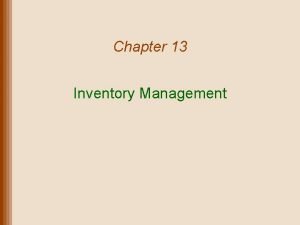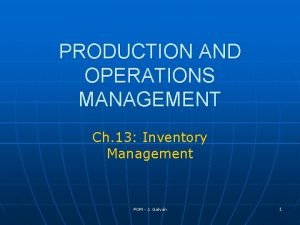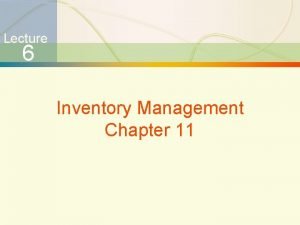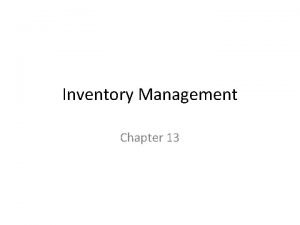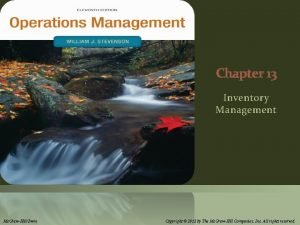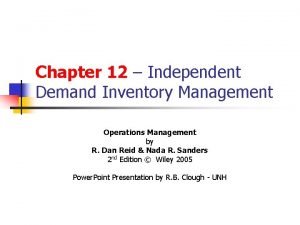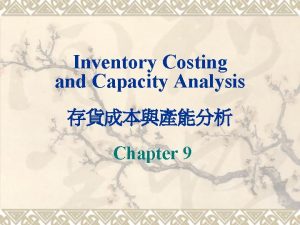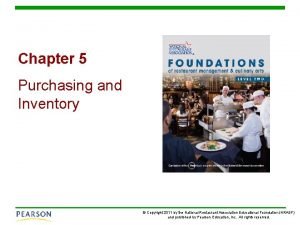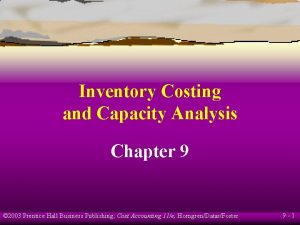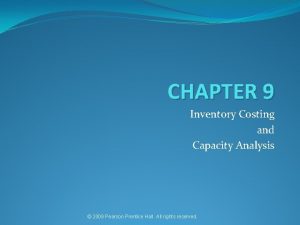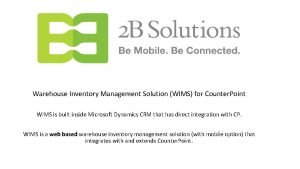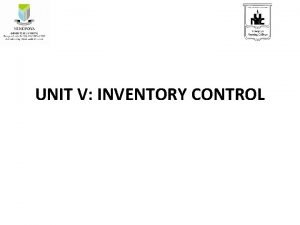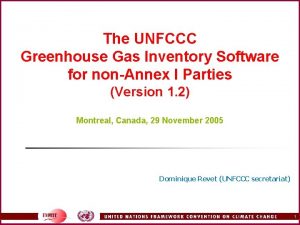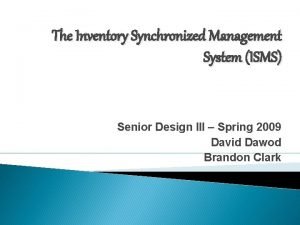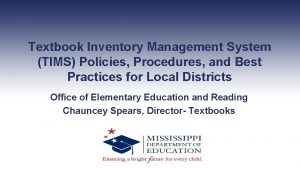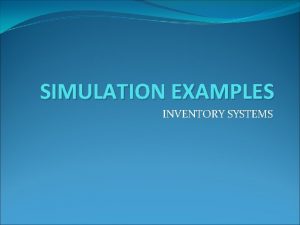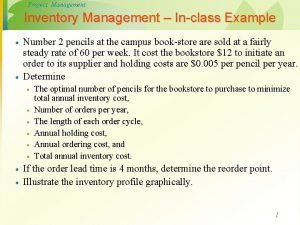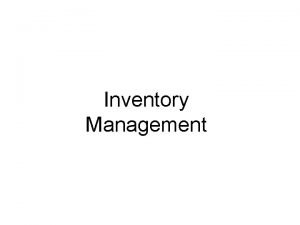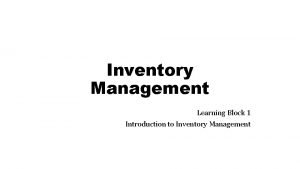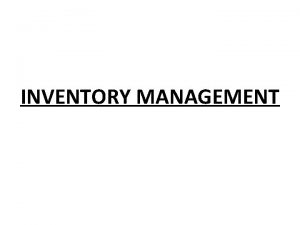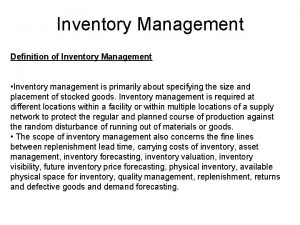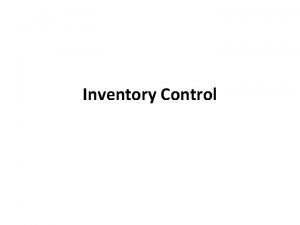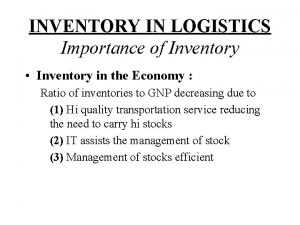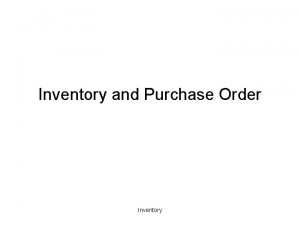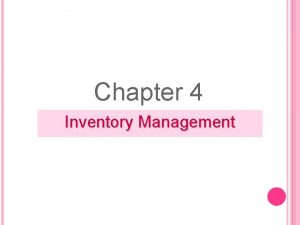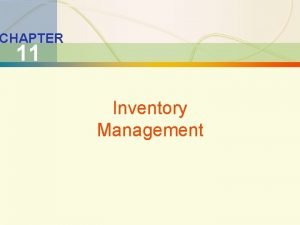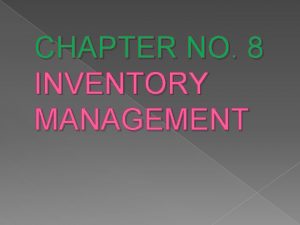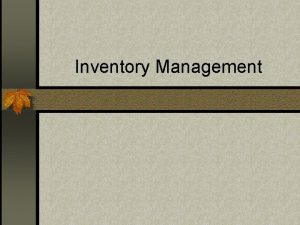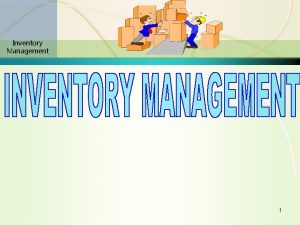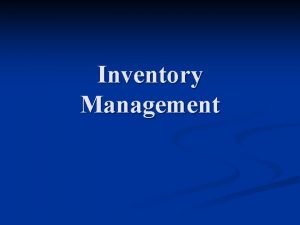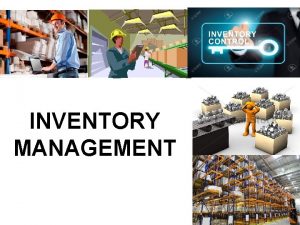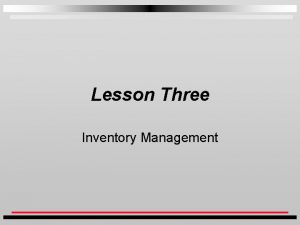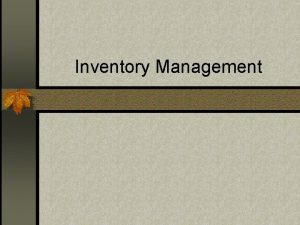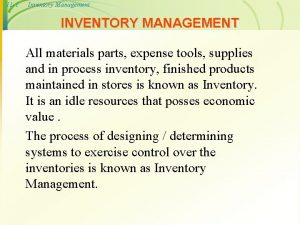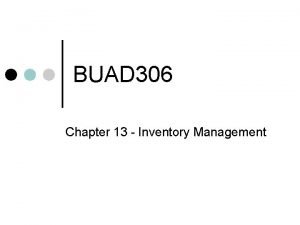Inventory Management Chapter 13 Inventory Management n An
























- Slides: 24

Inventory Management Chapter 13

Inventory Management n An inventory is a listing of all the goods or items that a business will use in its normal operation. n The goal of inventory management is to have drugs available (and usable) when they are needed. n Example: during flu season, the pharmacy might carry extra antibiotics, or cough medication.

Inventory Management n In some cases inventory management may be the technician’s primary responsibility. n The technician would be the “Pharmaceutical Buyer. ” n This would also require the technician to check all expiration dates and return all expired drugs according to the manufacturer’s requirements.

Formulary n Formulary: a list of medications that are approved for use. n Many hospitals, HMOs, insurers and other health care systems maintain a list of medications (formulary) that is for use within that system.

Formulary n An open formulary is one that allows the purchase of any medication that is prescribed. n The patient’s copay may vary depending upon the medication. n Generic drugs are usually first line therapy.

Formulary n A closed formulary is a limited list of medications. n A physician must receive permission to use a medication that is not on the list (prior authorization). n Generic drugs are usually the first line of therapy.

Legal Requirements n The DEA regulates the distribution of controlled substances, and has various inventory, record keeping and ordering requirements. n Schedule II substances must be: n Stocked separately in a secure place n Require special order forms for reordering n Inventory must be continuously monitored & documented (perpetual inventory)

Inventory Systems n A pharmaceutical inventory system is able to track inventory, forecast needs, and generate reorders to maintain adequate supplies. n Perpetual Inventory: maintains a continuous record of every item in the inventory so that it always shows the stock on hand.

Inventory Terms n Turnover: the rate at which inventory is used; it is generally expressed in the number of days. n Point of Sale System (POS): an inventory system which the item is deducted from inventory as it is sold or dispensed. n Reorder Points: minimum and maximum stock levels which determine when a reorder is placed and for what quantity.

Computers & Inventory n Computer inventory systems automatically adjust inventory & generate orders based on maintaining a set inventory levels. n Computers maintain a database; a collection of information structured so specific information can be retrieved and used. n It is important to enter information into the computer correctly to ensure quality inventory reporting. (Garbage in=Garbage

Automated Dispensing Systems n Automated counting/filling devices are sometimes used by pharmacies that dispense a high volume of prescriptions. n These devices have cells each of which is filled with a particular drug. n When a drug is ordered, the device counts the appropriate number of tablets or capsules into the vial.

Automated Dispensing Systems n Some devices also produce the prescription label. n Technicians must keep all the cells stocked and record the lot number and expiration date of all the drugs used. n Baker Cells is an example of an automated counting/filling device.

Automated Dispensing Systems n Automated point-of-use storage systems are for making floor stock items available to nurses in the hospital setting. n Storage stations are located throughout the facility and connected to the server and linked to the hospital’s billing and materials management system.

Automated Delivery Systems n The system tracks inventory, keeps a record of what drugs or supplies were taken by which nurse for which patient. n Pyxis Supply Station is an example of an automated pointof-use supply station.

Robotic Dispensing Devices n Centralized robotic dispensing devices can individually package and store large amounts of bulk supplies. n They can deliver bar coded Rxs to individual patient vials or return medication to storage.

Robotic Dispensing Systems n Some systems can prepare the prescription and generate a label, thus preparing an Rx for pharmacist inspection. n Robotic dispensing systems are used in very high volume pharmacies, such as mail order pharmacies. n Homerus is an example of a robotic

Key Computer Considerations n Manual Checking – Always double check! Data entry problems can be easily corrected if caught early. This eliminates stock problems, pricing & billing errors. n System Maintenance – It is important to learn the care, maintenance & back up requirements of your workplace system to avoid data loss or corruption.

Ordering n Ordering systems involve automated and manual activities. (see page 320) n It is very important to check the order being sent and the order that is received. n Ordering issues should be resolved immediately.

Ordering n Three-quarters of the pharmaceutical manufacturer’s sales are to drug wholesalers. n These wholesalers then sell their inventory to pharmacies, hospitals and other dispensers. n Drugs can also be purchased directly from the manufacturer.

Receiving n Accuracy is essential in checking in the medications received from suppliers. n Drugs that have been incorrectly picked, received damaged, are outdated or missing entirely must be reported immediately. n Discrepancies must be resolved with the vendor immediately.

Stocking & Storing n Most medications are received in bulk “stock bottles” that carry FDA required information on the label. n Some medications are packaged in individual doses called “unit-dose” packaging. n Regardless of packaging, all drugs must be stored according to the manufacturer’s specifications.

Stocking & Storing n Most drugs are kept in a fairly constant room temperature of 59º-86º F. n Only when the manufacturer specifies, should you store drugs less than room temperature. n The temperature of refrigeration should generally be 40º - 42º F.

Quarantined Stock n Stock that has expired, been damaged, recalled, or otherwise targeted for return or disposal must be segregated and clearly marked to avoid contamination, and/or mix-up with the good stock.

Chapter 13 n Read Chapter 13 n Review Forms pages 322 -323 n Review Key Concepts n Review Self-Test
 Chapter 12 inventory management
Chapter 12 inventory management Chapter 13 inventory management problems and solutions
Chapter 13 inventory management problems and solutions Chapter 13 inventory management
Chapter 13 inventory management Chapter 13 inventory management
Chapter 13 inventory management Chapter 13 inventory management
Chapter 13 inventory management Chapter 13 inventory management
Chapter 13 inventory management Independent demand
Independent demand Inventory costing and capacity analysis
Inventory costing and capacity analysis Chapter 5 purchasing and inventory
Chapter 5 purchasing and inventory Inventory costing and capacity analysis
Inventory costing and capacity analysis Chapter 9 inventory costing and capacity analysis
Chapter 9 inventory costing and capacity analysis Warehouse inventory management solution (wims)
Warehouse inventory management solution (wims) Meaning
Meaning Greenhouse inventory software
Greenhouse inventory software Conclusion of inventory management
Conclusion of inventory management Inquire
Inquire Inventory simulation excel
Inventory simulation excel Inventory management proposal
Inventory management proposal Gantt chart for inventory management system
Gantt chart for inventory management system Production planning inventory control
Production planning inventory control Mapics inventory management
Mapics inventory management Inventory management objective
Inventory management objective Introduction of inventory
Introduction of inventory Fsn meaning in inventory management
Fsn meaning in inventory management Dependent vs independent demand
Dependent vs independent demand

